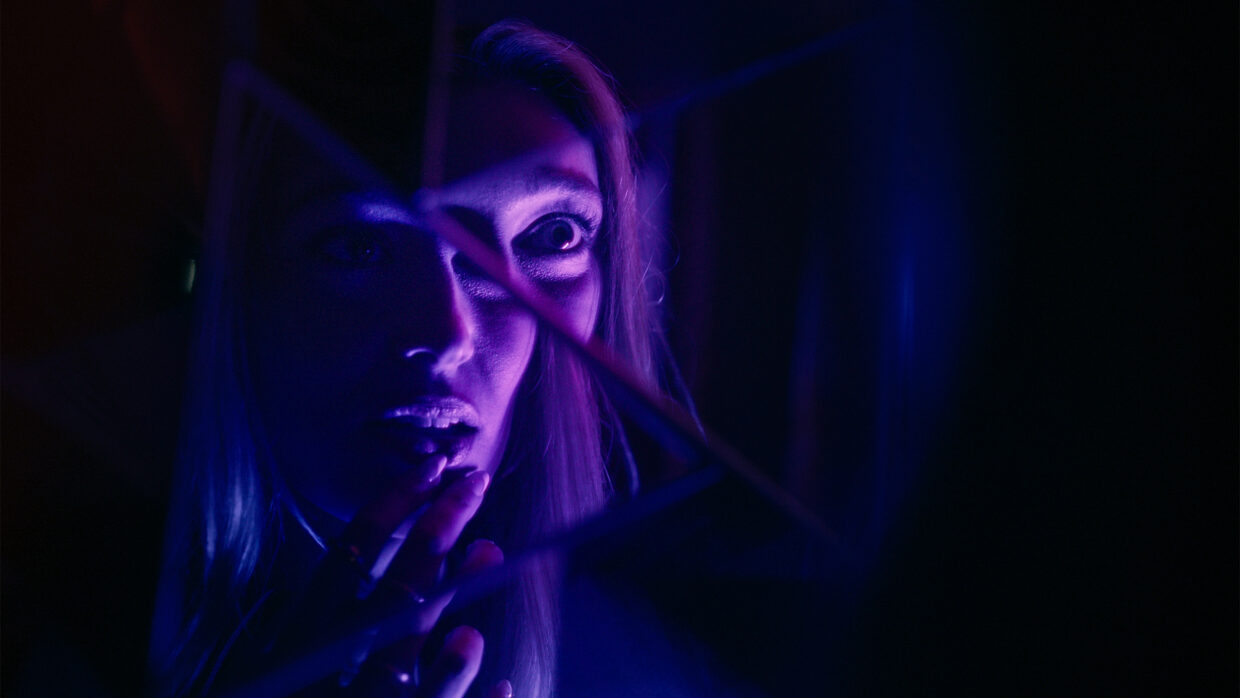 Back to selection
Back to selection
“I Get to Work with So Many Talented People”: DP Kevin Fletcher on It’s What’s Inside
 Alycia Debnam-Carey appears in It’s What’s Inside by Greg Jardin. Photo Courtesy of Sundance Institute.
Alycia Debnam-Carey appears in It’s What’s Inside by Greg Jardin. Photo Courtesy of Sundance Institute. In the Sundance 2024 Midnight premiere It’s What’s Inside, the feature debut of writer-director Greg Jardin, an uninvited guest with a mysterious suitcase derails a pre-wedding party.
The film’s colorful visual palette, realized by Kevin Fletcher, echoes the high-octane nature of the plot. Below, Fletcher shares some of the influences on the film’s distinct look and extols the virtues of preparatory work.
See all responses to our annual Sundance cinematographer interviews here.
Filmmaker: How and why did you wind up being the cinematographer of your film? What were the factors and attributes that led to your being hired for this job?
Fletcher: Writer-director Greg Jardin and I had worked together on many short form projects prior to this film—projects that included a lot of highly stylized techniques and visually stimulating concepts, often created by Greg. So, we have had a lot of time to hang out, become friends and to discuss movies, work, dreams, life, etc. I think it was this shared history and a respectful trust that led to me being hired for this film.
Filmmaker: What were your artistic goals on this film, and how did you realize them? How did you want your cinematography to enhance the film’s storytelling and treatment of its characters?
Fletcher: As per cinematography enhancing the storytelling and treatment of characters, this film asks some interesting questions about human nature and about how our views, actions and biases can color the world. It draws heavily from magical realism and feels simultaneously plausible and surreal. The incredible performances from the cast ground it in a contemporary reality that brings the story to life and makes for a uniquely entertaining film to watch. Visually amalgamating these themes and ideas was the artistic goal. A lot of energy, thought and passion was poured into it—I’m very proud of it.
Filmmaker: Were there any specific influences on your cinematography, whether they be other films, or visual art, of photography, or something else?
Fletcher: So many influences. We pulled ideas from everywhere—probably too many to list, but a few primary examples would be:
Directors: Nicolas Winding Refn, Steven Spielberg, Denis Villeneuve, Christopher Nolan
Cinematographers: Harris Savides, Christopher Doyle, Bradford Young, Benjamin Loeb
Movies/shows: Suspiria (1977), Mandy, In The Mood For Love, Munich, Drive, Only God Forgives, Children of Men, Sicario, Inception
Writers: Gabriel García Márquez, Jennifer Egan, William Gibson
Photographers: Weegee, Alex Webb, Gregory Crewdson, Trent Parke
Filmmaker: What were the biggest challenges posed by production to those goals?
Fletcher: I think the biggest challenge was the shooting schedule, especially since over half of our days were actually nights. We had ambitious ideas about camera movement, lighting and production design, so in order for Greg to have time with the cast, the lighting and camera work had to be decisive. Prep was crucial—intentionally designing shots and lighting plans ahead of time was the way we did it.
Filmmaker: What camera did you shoot on? Why did you choose the camera that you did? What lenses did you use?
Fletcher: Arri Alexa 35 with Leica Summilux C lenses and Angénieux Optimo Primes.
There were many reasons I chose this camera (latitude, low light capabilities, size, resolution). But the main reason is the new Arri sensor combined with the new color science, which is particularly adept at handling color in the red/magenta realm, something that is very important for this film.
Filmmaker: Describe your approach to lighting.
Fletcher: Wow—tough question. It’s such an amalgamation of components, and I know I don’t light the same for every job or story. Lighting is first and foremost an idea, and from this idea the tools and the execution follow. I spent a lot of time in prep discussing camera and lighting with Greg—talking about scenes, watching movies, sharing framegrabs, drawing sketches and taking photos. As our particular concepts got more solidified, I created to-scale lighting plans for the crew so we all had a shared road map of what was happening in each scene. I have to mention that this crew was amazing; they made a lot of my original ideas and sketches better.
Filmmaker: What was the most difficult scene to realize and why? And how did you do it?
Fletcher: I’m going to pass on answering this. It’s not that we didn’t have difficult scenes. But define “difficult”—so many variables. What I can say, again, is that we worked hard in prep to have clear plans for as much as we could. We brought together an incredibly talented group of storytellers and artists (often referred to as “crew”), and we worked together every day to turn this story into a one-of-a-kind movie.
Filmmaker: Finally, describe the finishing of the film. How much of your look was “baked in” versus realized in the DI?
Fletcher: The look of the film was primarily captured in-camera, but we also had a very talented colorist, Ryan McNeal, who added a lot of art to the story. Both Greg and I love the look of movies shot with film, so we knew from the beginning that we wanted a visual nod to that. Ryan applied Dehancer grain, a Kodak 250D negative profile and their Kodak 2883 print profile, which beautifully merged and enhanced our digital “negative.” I reiterate—the real value in the whole process of making a movie is the artist, not the tools. I feel grateful that I get to work with so many talented people.
TECH BOX
Film Title: It’s What’s Inside
Camera: Arri Alexa 35
Lenses: Leica Summilux C, Angénieux Optimo Primes
Lighting: You name it, we used it: LED, tungsten, HMI, practicals (phones, construction lights, 16mm film projector…)
Processing: ARRIRAW
Color Grading: Colorist – Ryan McNeal
